
Early on Wednesday, July 30, 2025, a powerful earthquake measuring 8.8 magnitude struck the Kamchatka Peninsula in Russia's far east, marking one of the most significant seismic events in decades. The tremor generated a tsunami with waves reaching heights of up to 4 meters (13 feet), causing widespread damage to structures and prompting evacuation warnings across several regions, including parts of Japan and the United States.
Kamchatka Governor Vladimir Solodov reported in a video shared via the Telegram messaging app that today’s earthquake was the strongest in recent memory, stressing the severity of the situation. He revealed that a kindergarten was among the buildings damaged due to the intense tremors. The first tsunami wave struck the coastal settlement of Severo-Kurilsk, located on Russia’s Kuril Islands, according to local governor Valery Limarenko.
The tsunami also reached parts of Kamchatka, with waves recorded at heights of 3-4 meters (10-13 feet). Additionally, the Japan Meteorological Agency reported that a tsunami wave of approximately 30 centimeters (about 1 foot) reached Nemuro on the eastern coast of Hokkaido.
In response to the earthquake, tsunami warnings were issued across the Pacific, affecting areas as far as Alaska, Hawaii, Chile, the Solomon Islands, and even extending towards New Zealand. Coastal areas of Ecuador were also alerted, with potential waves of over 3 meters expected along certain shorelines.
The quake's epicenter was located about 119 kilometers (74 miles) from Petropavlovsk-Kamchatsky, a city with a population of approximately 180,000.
Hawaii Governor Josh Green reported that while no significant tsunami wave had been observed so far, there was noticeable water receding along the coast. He emphasized that it may take several hours before an all-clear signal could be issued.
The Pacific Tsunami Warning Center recorded initial tsunami waves hitting Hawaii, with the tallest wave reaching 4 feet (1.21 meters) at Haleiwa on Oahu. CNN reported that water levels above 4 feet were noted on the north shore of Hawaii's Oahu island.
In Alaska, the first tsunami waves have begun to impact the shores, with severe alerts issued for parts of the Aleutian Islands and coastal regions. Evacuation centers have been set up in Hawaii as the state braces for potential further impact from the tsunami.
In response to the earthquake and subsequent tsunami, Russian authorities declared a state of emergency in the northern Kuril Islands, where flooding and structural damage were reported. Mayor Alexander Ovsyannikov confirmed that all residents had been evacuated to safety, emphasizing that timely measures were taken to ensure public safety.
In the United States, President Donald Trump urged residents in affected areas to stay safe following the tsunami warning. His message emphasized the importance of remaining vigilant as the situation unfolded across the Pacific.
A tsunami is a series of ocean waves that can be triggered by significant disturbances, such as earthquakes beneath the sea floor. The sudden movement of the Earth can displace large volumes of water, leading to waves that can travel across oceans at high speeds. Tsunamis are rare but can cause devastating flooding and powerful currents when they reach coastal regions.
As the situation develops, authorities across the Pacific are closely monitoring the impacts of the earthquake and tsunami, providing updates and safety guidelines to ensure public safety.